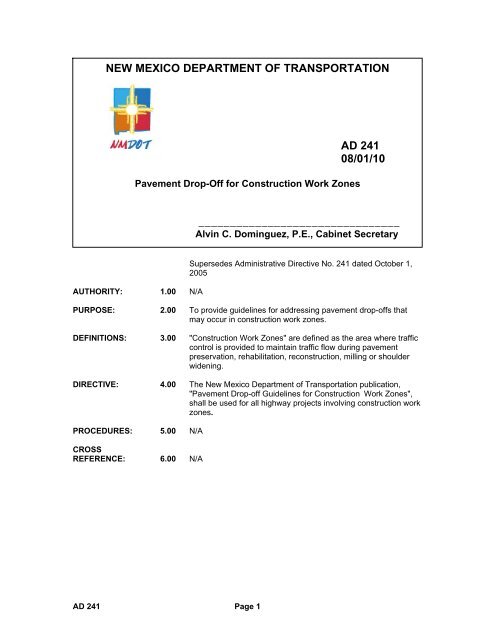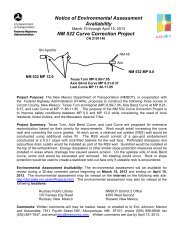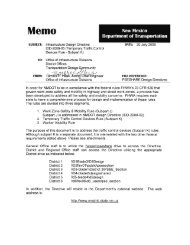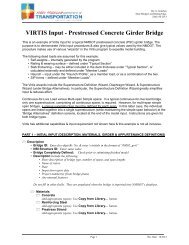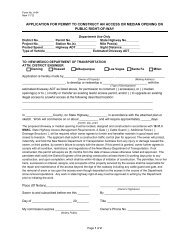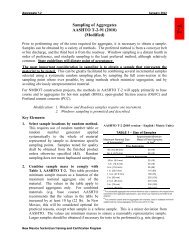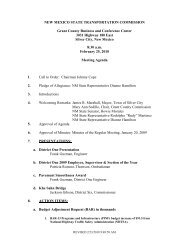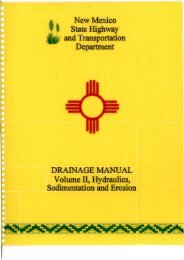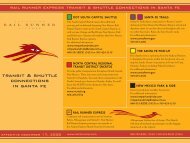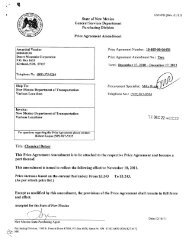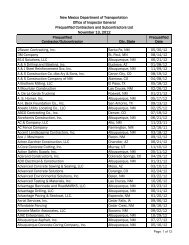AD-241 Department Drop-Off Guidelines - New Mexico Department ...
AD-241 Department Drop-Off Guidelines - New Mexico Department ...
AD-241 Department Drop-Off Guidelines - New Mexico Department ...
You also want an ePaper? Increase the reach of your titles
YUMPU automatically turns print PDFs into web optimized ePapers that Google loves.
NEW MEXICO DEPARTMENT OF TRANSPORTATION<br />
Pavement <strong>Drop</strong>-<strong>Off</strong> for Construction Work Zones<br />
AUTHORITY: 1.00 N/A<br />
<strong>AD</strong> <strong>241</strong><br />
08/01/10<br />
________________________________<br />
Alvin C. Dominguez, P.E., Cabinet Secretary<br />
Supersedes Administrative Directive No. <strong>241</strong> dated October 1,<br />
2005<br />
PURPOSE: 2.00 To provide guidelines for addressing pavement drop-offs that<br />
may occur in construction work zones.<br />
DEFINITIONS: 3.00 "Construction Work Zones" are defined as the area where traffic<br />
control is provided to maintain traffic flow during pavement<br />
preservation, rehabilitation, reconstruction, milling or shoulder<br />
widening.<br />
DIRECTIVE: 4.00 The <strong>New</strong> <strong>Mexico</strong> <strong>Department</strong> of Transportation publication,<br />
"Pavement <strong>Drop</strong>-off <strong>Guidelines</strong> for Construction Work Zones",<br />
shall be used for all highway projects involving construction work<br />
zones.<br />
PROCEDURES: 5.00 N/A<br />
CROSS<br />
REFERENCE: 6.00 N/A<br />
<strong>AD</strong> <strong>241</strong> Page 1
PURPOSE<br />
<strong>New</strong> <strong>Mexico</strong> <strong>Department</strong> of Transportation<br />
PAVEMENT DROP-OFF GUIDELINES FOR CONSTRUCTION WORK ZONES<br />
This document is introduced to provide guidance for addressing pavement drop-offs that may<br />
occur in construction work zones.<br />
BACKGROUND<br />
Pavement drop-offs occur when the longitudinal edge of the travel line is not flush with the<br />
adjacent existing surface. Pavement drop-offs can be created in construction work zones.<br />
Construction work zones are defined as the area where traffic control is provided to maintain<br />
traffic during pavement preservation, rehabilitation, reconstruction, milling and shoulder widening.<br />
APPLICATION<br />
This guideline is applicable to all highway construction work zones. To the extent possible, the<br />
following guidance should be used in the development of traffic control plans for all highway<br />
projects involving construction work zones. On very high volume roads (VHVR) where speeds<br />
are thirty miles per hour (30 mph) or less, or on very low volume roads (VLVR) where average<br />
daily traffic is estimated below 500 vehicles, these guidelines should be incorporated where<br />
practical.<br />
The following are example cases where a pavement drop-off may occur: (There may be<br />
situations that do not exactly fit one of the examples cases. In those situations, the case that<br />
most closely resembles the situation should be used.)<br />
<strong>AD</strong> <strong>241</strong> Page 2
PAVEMENT DROP-OFF CASES<br />
CASE I - Activities Within the Travel Lane Such as Milling or Overlay Operations.<br />
A maximum 1.5 in. vertical drop-off between adjacent surfaces will be allowed at the centerline, or<br />
lane lines without treatment. When the drop-off is greater than 1.5 in., a fillet with a slope of 6:1<br />
or flatter shall be provided during non-working hours. The work shall be scheduled to result in not<br />
more than one day operation of exposed longitudinal joint between adjacent surfaces.<br />
CASE II - Areas Adjacent to the Existing Travel Lane with Buffer Zones Less than 6 ft. In Width.<br />
A buffer zone is defined as any smooth, traversable surface that does not contain any obstruction<br />
or drop-offs.<br />
1) For travel lane widths within construction work zones of 11 ft. or more:<br />
a) A slope of 3:1 or flatter should be constructed whenever possible; however, a<br />
maximum 3 in. drop-off will be allowed without any special treatment. Vertical panels<br />
or other delineation devices shall be provided to delineate the drop-off.<br />
b) <strong>Drop</strong>-offs greater than 3 in. that are exposed to traffic during non-working hours shall<br />
be protected by a fillet (3:1 or flatter slopes) with delineation by drums, vertical panels,<br />
or other delineation devises. If fillet of less than 3:1 slope is not achievable, positive<br />
barrier (concrete wall barrier or approved equal) protection should be used.<br />
For travel lane widths within construction work zones of less than 11 ft., the procedure outlines<br />
under exceptions will apply.<br />
CASE III - Areas Adjacent to the Existing Travel Lane with Buffer Zones 6 ft. or More in Width.<br />
1) A slope of 3:1 or flatter should be constructed whenever possible.<br />
2) In those cases where a 3:1 or flatter slope is not possible, the following shall apply:<br />
a) For drop-offs less than 1 ft., vertical panels or other delineation devices shall be used.<br />
For drop-offs in excess of 1 ft., Type "B" drums at a spacing approved by the District Traffic<br />
Engineer or design team shall be used.<br />
CASE IV - Point <strong>Drop</strong>-offs Such as <strong>Drop</strong> Inlets and CBC Ends.<br />
When this type of drop-off is present, every effort should be made to place the appropriate<br />
permanent nature, such as guardrail or inlet grates, as soon as possible. The following<br />
temporary measures shall apply:<br />
1) For drop-offs located 6ft. or more from the travel lane, Type "B" drums shall be used to<br />
delineate the hazard.<br />
2) For drop-offs located less than 6 ft. from the travel lane, positive barrier (concrete wall<br />
barrier or approved equal) protection shall be provided. Type "B" drums may be used if<br />
the drop-off will be exposed for less than 24 hours.<br />
EXCEPTIONS<br />
During the development of a traffic control plan of a project, the drop-offs will be reviewed along<br />
with the required traffic control. If the criteria set forth in this guideline cannot be obtained<br />
through reasonable and prudent design practices an exception may be granted. The design team<br />
with the Project Development Engineer (PDE) as the lead member shall discuss the situation and<br />
provide a recommended course of action. The PDE shall initiate action for this to be processed<br />
as a design exception. For District lead projects, the District Technical Support Engineer will be<br />
the lead member.<br />
During the construction phase of a project, the project manager shall contact the Assistant District<br />
Engineer and District Traffic Engineer for guidance when the guideline criteria cannot be met.<br />
They shall provide a recommended course of action along with a change order to the appropriate<br />
Bureau, if required.<br />
<strong>AD</strong> <strong>241</strong> Page 3


